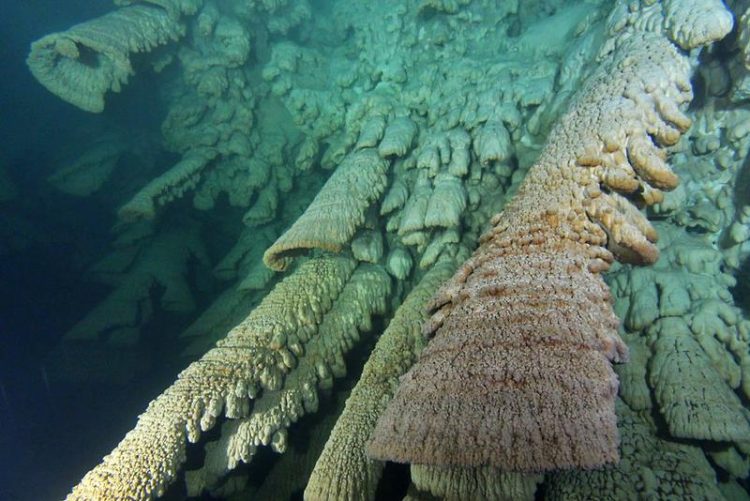Heidelberg Researchers Study Unique Underwater Stalactites

The Hells Bells in the El Zapote cave near Puerto Morelos on the Yucatán Peninsula. Source: E.A.N./IPA/INAH/MUDE/UNAM/HEIDELBERG
In recent years, researchers have identified a small group of stalactites that appear to have calcified underwater instead of in a dry cave. The Hells Bells in the El Zapote cave near Puerto Morelos on the Yucatán Peninsula are just such formations.
A German-Mexican research team led by Prof. Dr Wolfgang Stinnesbeck from the Institute of Earth Sciences at Heidelberg University recently investigated how these bell-shaped, metre-long formations developed, assisted by bacteria and algae. The results of their research have been published in the journal “Palaeogeography, Palaeoclimatology, Palaeoecology”.
Hanging speleothems, also called stalactites, result through physicochemical processes in which water high in calcium carbonate dries up. Normally they rejuvenate and form a tip at the lower end from which the drops of water fall to the cave floor.
The formations in the El Zapote cave, which are up to two metres long, expand conically downward and are hollow with round, elliptical or horseshoe-shaped cross-sections. Not only are they unique in shape and size, but also their mode of growth, according to Prof. Stinnesbeck. They grow in a lightless environment near the base of a 30 m freshwater unit immediately above a zone of oxygen-depleted and sulfide-rich toxic saltwater.
“The local diving community dubbed them Hells Bells, which we think is especially appropriate,” states Wolfgang Stinnesbeck. Uranium-thorium dating of the calcium carbonate verifies that these formations must have actually grown underwater, proving that the Hells Bells must have formed in ancient times. Even then the deep regions of the cave had already been submerged for thousands of years.
According to the Heidelberg geoscientist, this underwater world on the Yucatán Peninsula in Mexico represents an enigmatic ecosystem providing the conditions for the formation of the biggest underwater speleothems worldwide. Previously discovered speleothems of this type are much smaller and less conspicuous than the Hells Bells, adds Prof. Stinnesbeck.
The researchers suspect that the growth of these hollow structures is tied to the specific physical and biochemical conditions near the halocline, the layer that separates the freshwater from the underlying saltwater. “Microbes involved in the nitrogen cycle, which are still active today, could have played a major role in calcite precipitation because of their ability to increase the pH,” explains Dr Stinnesbeck.
Original publication:
Stinnesbeck, W., Frey, E., Zell, P., Avíles, J., Hering, F., Frank, N., Arps, J., Geenen, A., Gescher, J., Isenbeck-Schröter, M., Ritter, S., Stinnesbeck, S., Aceves Núñez, E., Fito Dahne, V., González González, A.H., Deininger, M.: Hells Bells – unique speleothems from the Yucatán Peninsula, Mexico, generated under highly specific subaquatic conditions. Palaeogeography, Palaeoclimatology, Palaeoecology, https://doi.org/10.1016/j.palaeo.2017.10.012
Contact:
Prof. Dr Wolfgang Stinnesbeck
Institute of Earth Sciences
Phone: +49 06221 54-6057
wolfgang.stinnesbeck@geow.uni-heidelberg.de
Communications and Marketing
Press Office
Phone +49 6221 54-2311
presse@rektorat.uni-heidelberg.de
Media Contact
More Information:
http://www.uni-heidelberg.deAll latest news from the category: Earth Sciences
Earth Sciences (also referred to as Geosciences), which deals with basic issues surrounding our planet, plays a vital role in the area of energy and raw materials supply.
Earth Sciences comprises subjects such as geology, geography, geological informatics, paleontology, mineralogy, petrography, crystallography, geophysics, geodesy, glaciology, cartography, photogrammetry, meteorology and seismology, early-warning systems, earthquake research and polar research.
Newest articles

Why Prevention Is Better Than Cure—A Novel Approach to Infectious Disease Outbreaks
Researchers have come up with a new way to identify more infectious variants of viruses or bacteria that start spreading in humans – including those causing flu, COVID, whooping cough…

Durable, Efficient, Sustainable: The Rise of Cerium Oxide Thermal Switches
Groundbreaking cerium oxide-based thermal switches achieve remarkable performance, transforming heat flow control with sustainable and efficient technology. Cerium Oxide-Based Thermal Switches Revolutionize Heat Flow Control Thermal switches, which electrically control…

How Industrial Robots are Reducing Emissions in Global Manufacturing
A new study explores the intersection of industrial automation and environmental sustainability, focusing on the role of industrial robots in reducing the carbon intensity of manufacturing exports. The research demonstrates…



